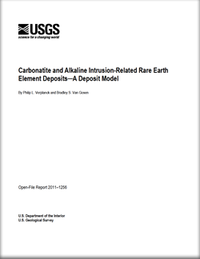The rare earth elements are not as rare in nature as their name implies, but economic deposits with these elements are not common and few deposits have been large producers. In the past 25 years, demand for rare earth elements has increased dramatically because of their wide and diverse use in high-technology applications. Yet, presently the global production and supply of rare earth elements come from only a few sources. China produces more than 95 percent of the world's supply of rare earth elements. Because of China's decision to restrict exports of these elements, the price of rare earth elements has increased and industrial countries are concerned about supply shortages. As a result, understanding the distribution and origin of rare earth elements deposits, and identifying and quantifying our nation's rare earth elements resources have become priorities. Carbonatite and alkaline intrusive complexes, as well as their weathering products, are the primary sources of rare earth elements. The general mineral deposit model summarized here is part of an effort by the U.S. Geological Survey's Mineral Resources Program to update existing models and develop new descriptive mineral deposit models to supplement previously published models for use in mineral-resource and mineral-environmental assessments. Carbonatite and alkaline intrusion-related REE deposits are discussed together because of their spatial association, common enrichment in incompatible elements, and similarities in genesis. A wide variety of commodities have been exploited from carbonatites and alkaline igneous rocks, such as rare earth elements, niobium, phosphate, titanium, vermiculite, barite, fluorite, copper, calcite, and zirconium. Other enrichments include manganese, strontium, tantalum, thorium, vanadium, and uranium.


